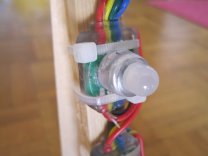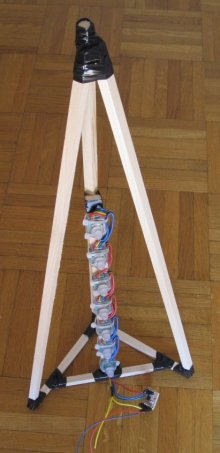Lampe à LEDs
Pour ce projet j'ai utilisé une chaine de LEDs adressables RVB. Cette chaine se commande par une liaison SPI en écriture seule. Il suffit donc de deux fils pour gérer plusieurs LEDs.
Cela m'aurait fait mal au coeur de consacrer un Arduino pour gérer cette lampe alors j'ai profité de tester l'ATTiny 85. Un petit micro-contrôleur de 8 pattes compatible. Suite à une erreur de commande j'en avais 4 en version SMD dans un tiroir.
Chaque LED est pilotée par un circuit de type WS2801. Ces circuits sont conçus pour être chainés. Pour gérer les LEDs il suffit d'envoyer le code couleur désiré (en RGB 3 x 8 bits) pour chaque LED en commençant par la première.
Le programme ci-dessous fait simplement une rotation de couleur (teinte de 0 à 359°) lentement en appliquant la même couleur sur toutes les LEDs. Il est clair que les possibilités d'une chaine de LEDs adressable vont bien au delà de cet exemple.
Lire ce tutoriel pour programmer un ATTiny depuis un Arduino.
#define CLK PB1 // Fil Bleu (clock)
#define STRIP_LENGTH 7 // Nombre de LEDs sur la chaîne
#define LEDS_BYTES STRIP_LENGTH*3
long strip_colors[STRIP_LENGTH];
int first_ptr = 0;
byte colors[LEDS_BYTES];
void setup() {
pinMode(SDI, OUTPUT);
pinMode(CLK, OUTPUT);
digitalWrite(CLK, LOW);
for(int i=0;i<STRIP_LENGTH;i++) setLedColor(i, 0);
post_frame();
}
long rgbToLong(long r, long g, long b) {
return (r<<16) | (g<<8) | b;
}
long hsv2rgb(float h, float s, float v) {
h /= 60;
int i = h;
float f = h - i;
long p = v * (1.0 - s);
long q = v * (1.0 - s * f);
long t = v * (1.0 - s * (1.0-f));
switch(i) {
case 0: return rgbToLong(v, t, p);
case 1: return rgbToLong(q, v, p);
case 2: return rgbToLong(p, v, t);
case 3: return rgbToLong(p, q, v);
case 4: return rgbToLong(t, p, v);
default: return rgbToLong(v, p, q);
}
}
void setLedColor(int led, long color) {
int ptr = led * 3;
colors[ptr++] = (color >> 16) & 0xFF;
colors[ptr++] = (color >> 8) & 0xFF;
colors[ptr++] = color & 0xFF;
}
void loop() {
static int hue = 0;
delay(500);
hue++;
if(hue==360) hue = 0;
for(int i=0;i<STRIP_LENGTH;i++) {
setLedColor(i, hsv2rgb(hue, 1, 255));
}
post_frame();
}
//Envoie les données de couleur aux LEDs
void post_frame (void) {
int ptr = first_ptr * 3;
for(int i=0;i<LEDS_BYTES;i++) {
byte b = colors[ptr];
for(int j=0;j<8;j++) {
digitalWrite(CLK, LOW);
digitalWrite(SDI, b & 0x80 ? HIGH : LOW);
b = b << 1;
digitalWrite(CLK, HIGH);
}
ptr++;
if(ptr==LEDS_BYTES) ptr = 0;
}
// Maintient clock en bas 500us pour faire un mode reset/post
digitalWrite(CLK, LOW);
delayMicroseconds(500);
}
Version avec télécommande IR
#if defined (__AVR_ATtiny45__) || (__AVR_ATtiny85__)
#include "PinChangeInterruptSimple.h" // mimics attachInterrupt() but a PCI for ATtiny
#define SDI PB0 // GREEN ON LED CHAIN
#define CLK PB2 // BLUE ON LED CHAIN
#define IR_PIN PB4 // IR SENSOR
#define MES_PIN PB3 // MESURE
#define DEBUG_PIN PB1 // DEBUG
#define BIT_DUR 880 // Full bit Duration Infrared reciever
#define LATCH_DELAY 65 // LED STRIP RESET
#endif
#if defined (__AVR_ATmega328P__)
const int CLK = 4;
const int SDI = 5;
const int IR_PIN = 2;
const int IR_PIN_INT = INT0;
const int BIT_DUR = 888; // Full bit Duration Infrared reciever
const int MES_PIN = 3; // MESURE
const int DEBUG_PIN = 6; // DEBUG
const int LATCH_DELAY = 650; // LED STRIP RESET
#endif
#define STRIP_LENGTH 7 // LEDs on this strip
#define LEDS_BYTES STRIP_LENGTH*3
long strip_colors[STRIP_LENGTH];
int first_ptr = 0;
byte colors[LEDS_BYTES];
byte programm = 1;
byte last_programm = 1;
#define NB_COLORS 6
const long default_colors[] = { 0xFF0000, 0x00FF00, 0x0000FF, 0xFF00FF, 0x00FFFF, 0xFFFF00 };
//------------------------------------- Télécommande IR -------------------------------------------
volatile int ir_key = -1;
// MAX 180 us on ATTiny @ 1MHz
// 18 us on ATMega @ 16MHz
void irRemote_ISR() {
static unsigned long irq_micros = 0;
static int buffer = 0;
static byte bit_cpt = 1;
static byte old_buffer_h = 0; // copie partie haute du buffer
unsigned long us = micros();
digitalWrite(MES_PIN, HIGH);
// interrupts();
unsigned long elapsed = us - irq_micros;
irq_micros = us;
if(elapsed > (BIT_DUR<<4)) { // FIRST PULSE > 16 BIT_DUR
bit_cpt = 0;
buffer = 0;
}
else if(elapsed > BIT_DUR+(BIT_DUR>>1)) { // LONG PULSE > 1.5 BIT_DUR
bit_cpt++;
}
bit_cpt++;
if(bit_cpt&1) {
buffer <<= 1;
if(digitalRead(IR_PIN)==LOW) { // RISING (Logique inversée)
buffer |= 1;
}
}
if(bit_cpt==27) {
byte bh = buffer>>8;
if(old_buffer_h != bh) { // evite les répétitions de touche
ir_key = buffer & 0x1FF;
old_buffer_h = bh;
}
}
// il peut y avoir une interruption supplémentaire (bit_cpt==28) pour les touches finissant par 1
digitalWrite(MES_PIN, LOW);
return;
}
//------------------------------------- LED Strip -------------------------------------------------
//Takes the current strip color array and pushes it out
void post_frame (void) {
noInterrupts();
int ptr = first_ptr * 3;
for(int i=0;i<LEDS_BYTES;i++) {
byte b = colors[ptr];
for(int j=0;j<8;j++) {
digitalWrite(CLK, LOW); //Only change data when clock is low
digitalWrite(SDI, b & 0x80 ? HIGH : LOW);
digitalWrite(CLK, HIGH); //Data is latched when clock goes high
b = b << 1;
}
ptr++;
if(ptr==LEDS_BYTES) ptr = 0;
}
//Pull clock low to put strip into reset/post mode
digitalWrite(CLK, LOW);
delayMicroseconds(LATCH_DELAY); //Wait for 500us to go into reset
interrupts();
}
void scrollUp(void) {
first_ptr++;
if(first_ptr==STRIP_LENGTH) first_ptr = 0;
}
void scrollDown(void) {
if(first_ptr==0) first_ptr = STRIP_LENGTH;
first_ptr--;
}
long rgbToLong(long r, long g, long b) {
return (r<<16) | (g<<8) | b;
}
long hsv2rgb(unsigned int hue, unsigned int sat, unsigned int val) {
unsigned int i = hue/60;
unsigned int bottom = ((255 - sat) * val)>>8;
unsigned int top = val;
byte rising = ((top-bottom) *(hue%60 ) ) / 60 + bottom;
byte falling = ((top-bottom) *(60-hue%60) ) / 60 + bottom;
switch(i) {
case 0: return rgbToLong(top, rising, bottom);
case 1: return rgbToLong(falling, top, bottom);
case 2: return rgbToLong(bottom, top, rising);
case 3: return rgbToLong(bottom, falling, top);
case 4: return rgbToLong(rising, bottom, top);
case 5: return rgbToLong(top, bottom, falling);
}
}
void setLedColor(int led, long color) {
int ptr = led * 3;
colors[ptr++] = (color >> 16) & 0xFF;
colors[ptr++] = (color >> 8) & 0xFF;
colors[ptr++] = color & 0xFF;
//strip_colors[led] = (r<<16) | (g<<8) | b;
}
/*
long getLedColor(int led) {
int ptr = led * 3;
long color;
color = colors[ptr++];
color <<= 8;
color |= colors[ptr++];
color <<= 8;
color |= colors[ptr++];
return color;
}
*/
void setup() {
#if defined (__AVR_ATmega328P__)
Serial.begin(9600);
#endif
pinMode(SDI, OUTPUT);
pinMode(CLK, OUTPUT);
pinMode(MES_PIN, OUTPUT);
pinMode(IR_PIN, INPUT);
pinMode(DEBUG_PIN, OUTPUT);
digitalWrite(MES_PIN, LOW);
digitalWrite(CLK, LOW);
digitalWrite(DEBUG_PIN, LOW);
#if defined (__AVR_ATmega328P__)
attachInterrupt(IR_PIN_INT, irRemote_ISR, CHANGE);
#endif
#if defined (__AVR_ATtiny45__) || (__AVR_ATtiny85__)
attachPcInterrupt(IR_PIN, irRemote_ISR, CHANGE);
#endif
}
void setStripColor(unsigned long color) {
for(int i=0;i<STRIP_LENGTH;i++) {
setLedColor(i, color);
}
}
void hueRotator() {
static int hue = 0;
hue++;
if(hue==360) hue = 0;
setStripColor(hsv2rgb(hue, 255, 255));
}
void disco() {
if(programm!=last_programm) {
for(int i=0;i<STRIP_LENGTH;i++) {
setLedColor(i, default_colors[random(NB_COLORS)]);
}
}
scrollUp();
}
void disco2() {
static int hue = 0;
const int div = 4;
static int cpt = div;
if(cpt--!=0) return;
cpt = div;
hue++;
if(hue==NB_COLORS) hue = 0;
setStripColor(default_colors[hue]);
}
void loop() {
int key = ir_key;
ir_key = -1;
switch(programm) {
case 1:
setStripColor(0xFFFFFF);
break;
case 2:
setStripColor(0xFF0000);
break;
case 3:
setStripColor(0x00FF00);
break;
case 4:
setStripColor(0x0000FF);
break;
case 5:
setStripColor(0xFF00FF);
break;
case 6:
setStripColor(0x00FFFF);
break;
case 7:
setStripColor(0xFFFF00);
break;
case 8:
hueRotator();
break;
case 9:
disco();
break;
case 0:
disco2();
break;
default: // noir
setStripColor(0x000000);
}
last_programm = programm;
if(key>=0) {
programm = key;
}
post_frame();
delay(112);
}


